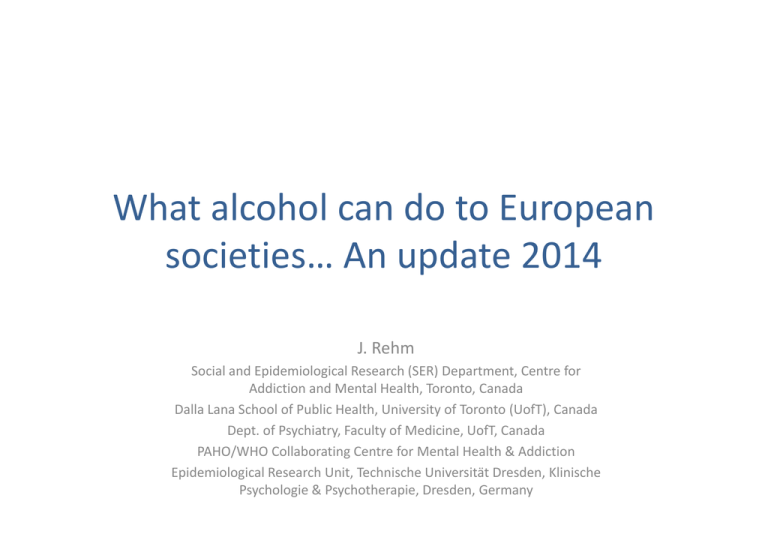What alcohol can do to European societies… An update
advertisement

What alcohol can do to European societies… An update 2014 J. Rehm Social and Epidemiological Research (SER) Department, Centre for Addiction and Mental Health, Toronto, Canada Dalla Lana School of Public Health, University of Toronto (UofT), Canada Dept. of Psychiatry, Faculty of Medicine, UofT, Canada PAHO/WHO Collaborating Centre for Mental Health & Addiction Epidemiological Research Unit, Technische Universität Dresden, Klinische Psychologie & Psychotherapie, Dresden, Germany Basis Many peer‐ reviewed publications on details in the last three years E‐book Second edition available on www.amphoraproject.net/ 3 CHAPTER 2: WHAT ALCOHOL CAN DO TO EUROPEAN SOCIETIES Jürgen Rehm, Gerrit Gmel, Maximilien X. Rehm, Emanuele Scafato, Kevin D. Shield • We have estimated alcohol‐attributable mortality and burden of disease • Using the methodology of the Comparative Risk Assessment for alcohol within the Global Burden of Disease and Injury 2005/2010 Study (GBD). • In addition, we have tried to develop guidelines for monitoring and surveillance based on efforts of the EU, the World Health Organization and the GBD study. 4 Currently used model for alcohol comparative risk assessment Population group Societal Factors Drinking culture Alcohol Policy Drinking environment (individual) Gender Alcohol consumption Volume Patterns Incidence chronic conditions including AUDs Health care system Quality Incidence acute conditions Health outcomes Mortality by cause Age Poverty Marginalization Trends in recorded consumption in the EU • Overall trends for EU or EU plus Croatia, Norway and Switzerland are down for the past 20 years. • Actually, the EU would fulfill the NCD criteria of – 10% for NCDs. • However, this is not true for all countries, nor for all regions Regional categorisation Countries within each European region Central West and Western Europe: Austria, Belgium, France, Germany, Ireland, Luxembourg, Netherlands, Switzerland and the United Kingdom Central‐East and Eastern Europe: Bulgaria, Czech Republic, Estonia, Hungary, Latvia, Lithuania, Poland, Romania, Slovakia and Slovenia Nordic countries: Denmark, Finland, Norway and Sweden Southern Europe: Cyprus, Greece, Italy, Malta, Portugal and Spain European Union & Switzerland, Norway and Croatia Recorded adult per capita consumption of alcohol (litres of pure alcohol) E U .plus.S w itzerland.N orw ay.and.C roatia Year_RC 12 11 10 9 0 5 10 15 1990 1995 2000 2005 2010 Year 20 But differences in regions with respect to levels and trends Score lower =better 1.0 1.5 2.5 2.9 Lowest within EU 1.9 2.8 high 2.0 1.1 high 1.6 1.9 Level West‐ Central West East‐ Central East Nordic countries South EU plus N, Croatia, CH Patterns Unrecorded In l pure pc Very high Very high Trend And some country differences (recorded only) 20,0 18,0 16,0 14,0 Italy 12,0 Germany Spain 10,0 UK Poland 8,0 6,0 4,0 Alcohol consumption in Europe 2012 Adult per capita consumption (ethanol): Green: 5 ‐ < 8 litres Yellow: 8 ‐ < 10 l Orange: 10 ‐ < 12 l Red: 12‐ < 15 l Dark red: 15+ l Cancer, liver cirrhosis and injury cover 90% of all net alcohol‐attributable deaths; 2012 harm is still high in Europe ALCOHOL‐ATTRIBUTABLE HEALTH HARM Alcohol‐attributable liver cirrhosis, cancer and injury deaths 2010 Alcohol‐attributable deaths in Europe 2012 In % of all adult deaths: Green: <2.5% Yellow: 2.5 ‐ <5% Orange: 5 ‐<7.5% Red: 7.5 ‐ <10% Brown: 10+ % Alcohol‐attributable DALYs in Europe 2012 In % of all adult DALYs: Green: < 2.5% Yellow: 2.5 ‐ <5% Orange: 5 ‐ <7.5% Red: 7.5 ‐ <10% Brown: 10+ % Comparison to other risk factors Western Europe 2010 More burden in Eastern Europe 2010 j2 And it is not only health burden Individual Family Health burden Morbidity from diseases caused or worsened by AD and associated premature mortality Injury; stress-related Injury problems for other family members; FASD; interpersonal violence Social burden Decreases in functionality associated with AD (blackouts, hours of drunkenness); decrease in social role; loss of friendships; stigma Problems with parental roles, partnership roles, and roles as caregiver in general (e.g., to parents) Team problems; others Social costs of alcohol; having to compensate for vandalism lack of productivity Financial problems resulting from health and social consequences of alcohol impacting on family budget and household expenses Absenteeism and other productivity costs (mainly suboptimal performance when working and disability, short- and long-term); replacement costs in case of premature mortality or long-term disability Economic Dependent on society and on SES of person burden with AD; often cost of alcohol plus cost of possible job loss or absenteeism; possible social drift downwards Work Society Acute care hospitalisations for health problems caused by alcohol; injuries; infectious diseases; FASD Productivity losses; health care costs; costs in the legal sector (police, court, prisons) Diapositiva 18 j2 Please provide reference details. jenny; 17/02/2012 Conclusions • Divergent trends in alcohol consumption in Europe: some good signs, and some bad signs • Overall Europe is still the region with the highest alcohol consumption in the world (Eastern Europe higher than EU). • So overall, harm is still high (more than every 10th death before age 65 in EU is due to alcohol!) and can and should be reduced. • Harm is not restricted to health or to the drinker Need for interventions • Prevention is important (and Italy knows best) • WHO “best buys” for cost‐effective prevention ‐> – Taxation – Reduction of availability – Marketing ban • Let us not forget interventions for heavy drinking including treatment What should interventions take into account? • It is important to reduce the highest levels of drinking in order to Relative gain in risk for mortality of reducing by prevent harm three drinks/day for different levels of drinking Relative risk for mortality Relative risk for mortality Typical risk curve for alcohol (e.g., liver cirrhosis mortality) Drinks per day Drinks per day Roerecke & Rehm, 2013 Alc.Alc











